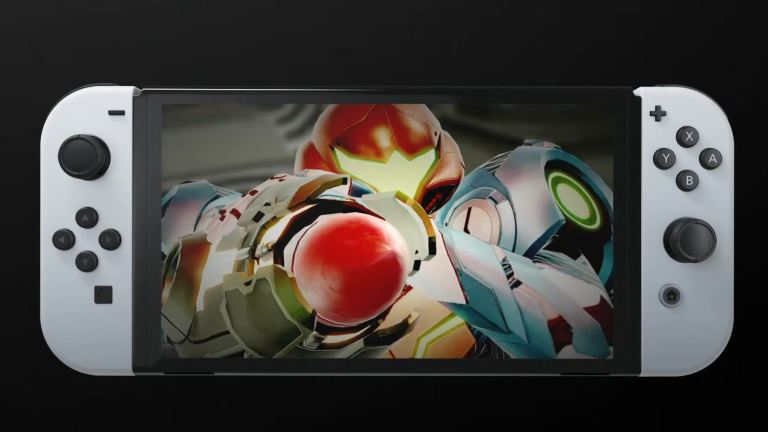Nintendo Switch OLED is Not the Switch Pro You Were Looking For
The Nintendo Switch OLED is certainly an upgrade, but what happened to the rumored Nintendo Switch Pro?

After over a year of rumors regarding a possible Switch upgrade, Nintendo has finally revealed the Nintendo Switch OLED: a surprisingly minor upgrade that has fans wondering whether or not this is indeed the Nintendo Switch Pro they’ve been waiting for.
Before we go any further, take take a look at the Nintendo Switch OLED’s main features and how it improves (or distinguishes itself from) the “base” Nintendo Switch:
- 7 inch OLED screen (up from the base Switch’s 6.2 inch LCD screen)
- 64 GB internal storage (32 GB internal storage in base Switch)
- Wider stand with additional adjustment options
- Wired LAN port in dock
- 4” high, 9.5” long, and .55” deep dimensions with Joy-Cons attached (4” high, 9.4” long, and .55” deep dimensions for base Switch)
- Improved built-in speakers
- New “default” color option
- 0.93 lbs weight (0.88 lbs weight for base Switch)
While nearly all of those features will certainly be welcomed by Nintendo Switch fans looking for some kind of upgrade, others are having a hard time looking at the Nintendo Switch OLED and not seeing the Nintendo Switch Pro that has been slowly shaped by rumors for well over a year now.
To give you a better idea of what we’re talking about, here are a few of the features you won’t find in the Nintendo Switch OLED:
- Improved performance/processing hardware
- Upgraded resolution (Nintendo Switch OLED offers 1280x720p resolution with improved picture contrast)
- 4K output in docked mode
- Improved battery life (both the OLED and base Switch offer roughly 4.5 – 9 hours of battery life)
The Nintendo Switch OLED obviously falls well short of the rumored Nintendo Switch Pro that so many people hyped themselves up for, but the big question at the moment has to be “Is the Nintendo Switch OLED the ‘real’ Nintendo Switch Pro, or is it just a stepping stone for a future upgrade?”
To be entirely honest, nobody outside of Nintendo seems to know the exact answer to that question. Bloomberg reporter Jason Schreier was asked about the rumored Nintendo Switch Pro on Twitter, and even he seems to be unsure what the reveal of the Nintendo Switch OLED means for the state of the Nintendo Switch Pro at the moment:
At the moment, though, the most popular theory is that the Nintendo Switch OLED and the Nintendo Switch Pro (or whatever it may eventually be called) are two different consoles. Not only are the Nintendo Switch Pro rumors incredibly well-sourced, but it’s reasonable to suspect that the planned production of any substantially upgraded Nintendo Switch console may be delayed at the moment by the same shortages currently impacting the PS5 and Xbox Series X/S. It’s a very difficult time to release a “next-gen” console, and Nintendo may be right to not even try and mass manufacture such a device until things settle down a bit.
Even if we do eventually get a Nintendo Switch Pro, though, there’s still quite a bit of confusion regarding what the Nintendo Switch OLED actually is in terms of the company’s long-term hardware strategy. It’s unlikely that they just decided to release the Switch OLED on a whim while they wait out component shortages, but it’s kind of hard to call this an upgrade unless you happen to play your Nintendo Switch more in handheld mode. The improved internal storage is nice, but most Switch owners have probably purchased a microSD card by now. The new dock’s LAN port is also neat, but since you can use your base Switch in the OLED dock, you don’t even need to buy the new console to enjoy that feature.
To be fair, Nintendo’s published user data does somewhat support the Switch OLED’s core features. In 2017, the company published a report that revealed 30% of Nintendo Switch users primarily play in handheld mode, 20% primarily play in docked mode, and 50% regularly alternate between both styles or otherwise have no strong preference. It’s not clear what those numbers look like these days, but given the handheld-focused design of the Nintendo Switch Lite and Nintendo Switch OLED, it wouldn’t be surprising to learn that more people still prefer to play the Nintendo Switch in handheld mode (at least according to Nintendo’s research).
More importantly, it’s pretty clear at this point that Nintendo doesn’t plan to release a dedicated handheld successor to the Nintendo 3DS anytime soon. That being the case, it makes sense that they’re trying to emphasize the Switch’s handheld features for those who are looking for a “new” handheld Nintendo console. Actually, it’s almost certainly not a coincidence that the Nintendo Switch OLED will be available in time for the release of Metroid Dread: a classic-style Metroid experience that may have otherwise been released on a “dedicated” Nintendo handheld device.
Having said that, this obviously isn’t the Nintendo Switch upgrade that some were expecting/waiting for. Even still, the call of the Nintendo Switch OLED may prove to be too strong to ignore when the console is released on October 8th.
